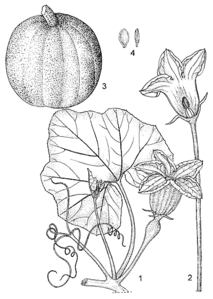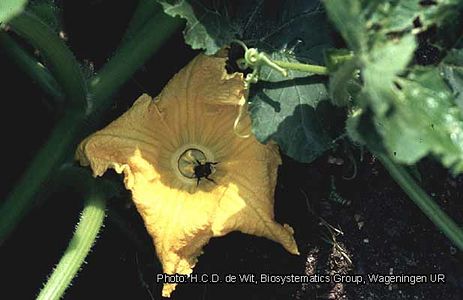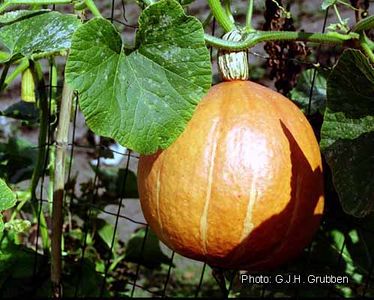Cucurbita maxima
De PlantUse Français
Cucurbita maxima Duchesne
| Ordre | Cucurbitales |
|---|---|
| Famille | Cucurbitaceae |
| Genre | Cucurbita |
2n = 40
Origine : aire d'origine
sauvage ou cultivé
| Français | potiron |
|---|---|
| Anglais | pumpkin |
Résumé des usages
- fruit comestible
- médicinal
Sommaire
Description
- Fruits de formes et de couleurs variés mais jamais de couleur jaune.
- Pédoncule court rond et liégeux.
Noms populaires
| français | potiron |
| anglais | winter squash, pumpkin |
| allemand | Riesenkürbis |
| néerlandais | pompoen |
| italien | zucca d’inverno |
| espagnol | zapallo, calabaza ; auyama (Venezuela) |
| portugais | abóbora ; morango (Brésil) |
- Voir les noms de la Flore populaire d'Eugène Rolland
Classification
Cucurbita maxima Duchesne (1786)
Cultivars
Classification d'Andres
- var. boliviana Zhiteneva, Trudy po Prikladnoi Botanike, Genetike i Selektsii 23(3): 185, f. 33–35. 1930.
- var. chiloensis Zhiteneva, Trudy po Prikladnoi Botanike, Genetike i Selektsii 23, no. 3: 185. 1930.
- var. parvifructina Grebenscikov, Die Kulturpflanze 6: 50.
- var. peruviana Zhiteneva, 1930.
- var. triloba Millan, Darwiniana 7: 342, t. 4, A–D. 1947.
- subsp. turbaniformis (M. Roem.) Vass.
- var. turgida L.H. Bailey, Gentes Herbarium; occasional papers on the kind of plants 7: 470, f. 238–239. 1948.
- var. zapallito (Carriere) Millan, Darwiniana 7: 334. 1947.
- var. zipinka Millan, Darwiniana 7: 341, f. 1, F; tab 3, B-H. 1947.
Classification de Goldman
- Australian Blue : blue-rinded squashes with a long post-harvet life, popular Down Under
- Banana : elongated types, in several colors, usually tapered at the stem and blossom ends
- Buttercup : small drum-shape pumpkins with an "acorn", not prominent, at the blossom end
- Hubbard : big and bulky bruisers, smooth-rinded or warted, of excellent table quality, in blue, red, or green
- Mammoth : exhibition squashes weighing one hundred pounds or more
- Turban : not strictly ornamental, similar to Buttercups, but the acorn is more prominent
- Zapallito : petite fruits grown on short-running vines or bushy plants
- Miscellaneous : unclassified maximas.
Classification de la BD Mansfeld
Austroamerican Group
- var. turgida L.H. Bailey (1948)
- subsp. americana Filov (1966), p.p.
Banana Group
- "Banana group" Cast. & Erw. (1927)
- convar. bananina Grebenšč. (1958)
- var. odorifera Filov (1982), nom. inval.
Hubbard Group
- var. ohio Naud.(1982), sensu Filov in Fursa & Filov
- "Hubbard group" Cast. & Erw. (1927)
- convar. hubbardina Grebenšč. (1958)
Mammoth Group
- Var.-Gr. ecoronata Alef. (1866), p.p.
- "Mammoth group" Cast. & Erw. (1927)
- convar. maxima in Mansfeld (1986)
Parvifructina Group
- convar. parvifructina Grebenšč. (1958), p.p.
Turban Group
- "Potiron couronnes ou Turbans" Naud. (1856)
- Var.-Gr. semiturbana Alef. (1866)
- Var.-Gr. turbaniformis (M.J. Roem.) Alef. (1866)
- "Turban group" Cast. & Erw.(1927)
- subsp. turbankurbis Filov, sensu lato, incl. vars.
- convar. turbaniformis (M.J. Roem.) Grebenšč. (1958)
Zapallito Group
- var. zapallito (Carr.) Millan (1947)
- var. zipinca Millan (1947)
- var. triloba Millan (1947)
- convar. zapallitina Grebenšč. (1958)
subsp. andreana (Naud.) Filov (1966)
Groupe Potiron plat
- 'Aconcagua'
- 'Adriatica'
- 'Ambar'
- 'Australian Butter'
- 'Bal Kabagi'
- 'Black Prince'
- 'Bleu de Hongrie'
- 'Bleu de Turquie'
- 'Buen Gusto'
- 'Buttercup Bush'
- 'Chersonskaya'
- 'Chesnut'
- 'Crioula Pataka'
- 'D'Argentine'
- 'Des Açores'
- 'D'Espelette'
- 'Eden White'
- 'Diu'
- 'Du Paraguay'
- 'Fatima'
- 'Flat Odenwander'
- 'Flat White Boer'
- 'Galeux d’Eysines'
- 'Garbo'
- 'Golden Nugget'
- 'Griborskay '
- 'Hopi Orange'
- 'Hopi White'
- 'Iran'
- 'Ironbark'
- 'Istanbul'
- 'Jarrahdale'
- 'Karli'
- 'Moranga Esposiçao'
- 'Rouge Vif d'Etampes'
- 'Sweet Meat'
- 'Türkischer Bergkürbis'
- 'Valenciano'
- 'Volga River'
- 'Whangaparoa'
- 'Zapallo Camote'
- 'Zapallo Macre'
- 'Zapallo Plomo'
Groupe Hubbard
Groupe Delicious
Groupe Hokkaido
fr. : potimarron
Groupe Banana
Groupe Turban
Groupe Mammoth
Gros fruits sans intérêt culinaire.
- 'America'
- 'Amerikanish Pumpkin'
- 'Atlantic Giant'
- 'Bambino'
- 'Big Max'
- 'Big Moon'
- 'Blanc du Dauphiné'
- 'Bulgarian Balloon'
- 'Courge du Pérou'
- 'D'Iran'
- 'Du Maine'
- 'Full Moon'
- 'Gaillot'
- 'Géante Standard'
- 'Gele Centenaar'
- 'German'
- 'Hungarian Mammoth'
- 'King of Mammoth'
- 'Mammoth Gold'
- 'Melonowa Zolta'
- 'One Too Many'
- 'Pacific Giant'
- 'Rainbow'
- 'Sumo'
- 'Titan'
- 'Wyatt's Wonder'
Groupe Miscellaneous
En attente de classement dans un des groupes ci-dessus.
- 'Alexander's Copper'
- 'Amazonka'
- 'Amish Pie'
- 'Balloon'
- 'Bela Bundeva'
- 'Blanche de Lyon'
- 'Blue Ballet'
- 'Colinki'
- 'Courge Olive'
- 'Durmitor'
- 'Emu Seven'
- 'Essex Turban'
- 'Ethiopial'
- 'Gold Keeper'
- 'Herrenkürbis'
- 'Hidatsa'
- 'Indian Pumpkin'
- 'Kalonice'
- 'Kiszombori'
- 'Lakota'
- 'La Tunisienne'
- 'Libra'
- 'Lower Salmon River'
- 'Mayo Blusher'
- 'Mini Rose du Brésil'
- 'Moranga Coroa'
- 'Moravka'
- 'Mormon Squash'
- 'Mooregold'
- 'Odawa's Runner'
- 'Taos'
- 'Turtle'
- 'Verruqueux du Portugal'
- 'Vert d'Espagne'
- 'White Pumpkin'
- 'Zapallo Grande de Guarda'
- 'Zipinki Campana'
Histoire
- Voir Squashes in Buffalo Bird Woman's Garden Recounted by Maxi'diwiac (Buffalo Bird Woman) of the Hidatsa Indian Tribe (ca.1839-1932), edited by Gilbert Livingstone Wilson (1868-1930). Originally published as "Agriculture of the Hidatsa Indians: An Indian Interpretation" by Gilbert Livingstone Wilson, Ph.D. (1868-1930) Minneapolis, The University of Minnesota (Studies in the Social Sciences, #9), 1917. Ph. D. Thesis. Récit passionnant de première main.
Usages
Références
- Castetter, E.F. & Erwin, A.T., 1927. A systematic study of squashes and pumkins. Iowa Agr. Exp. Sta. Bull., 21(244) : 103-135. A chercher. Serait la première source pour les groupes. en ligne
- Chauvet, Michel, 2018. Encyclopédie des plantes alimentaires. Paris, Belin. 880 p. (p. 221)
- Defay, Bruno, 1993. Trésors de courges et de potirons. Jardinage et cuisine. Paris, Terre vivante. 95 p.
- Ferriol, María ; Picó, Belén & Nuez Fernando, 2004. Morphological and Molecular Diversity of a Collection of Cucurbita maxima Landraces. Journal of the American Society for Horticultural Science, 129 (1) : 60–69. Propose une nouvelle classification.
- Giannini T.C., Saraiva, A.M. & Alves-dos-Santos, I.A., 2009. Ecological niche modeling and geographical distribution of pollinator and plants: A case study of Peponapis fervens (Smith, 1879) (Eucerini: Apidae) and Cucurbita species (Cucurbitaceae). Ecological Informatics.
- Goldman, Amy. 2004. The compleat squash: A passionate grower's guide to pumpkins, squashes, and gourds. New-York, Artisan. 215 p.
- Grebenščikov, Igor, 1958. Notulae cucurbitologicae III. Kulturpflanze, 6 : 38-60.
Liens
- BHL
- Collection Nationale de Cucurbitacées (CCVS)
- FAO Ecocrop
- Flora of China
- GRIN
- IPNI
- Louie's Pumpkin Patch
- Mansfeld
- Moerman, Native American Ethnobotany
- Multilingual Plant Name Database
- Plant List
- Plants for a future
- PROSEA sur Pl@ntUse
- PROTA sur Pl@ntUse
- NewCrop Purdue
- Tela Botanica
- Useful Tropical Plants Database
- Wikipédia





